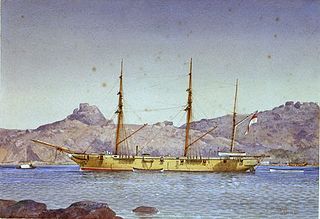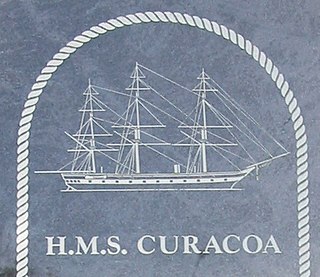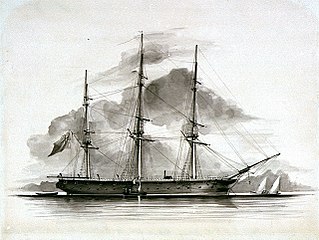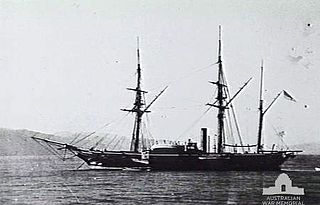
HMS Hornet was a 17-gun wooden screw sloop of the Cruizer class of the Royal Navy, launched in 1854 and broken up in 1868.
HMS Highflyer was a 21-gun wooden screw frigate of the Royal Navy. She was built on the River Thames by C J Mare and launched on 13 August 1851. She spent twenty years in service, including action in the Crimean War and the Second Opium War, before being broken up at Portsmouth in May 1871.

The Cruizer class was a class of six 17-gun wooden screw sloops built for the Royal Navy between 1852 and 1856.

HMS Niger was originally slated to be built as a Sampson designed sloop; however, she was ordered as a First-Class sloop with screw propulsion on 20 February 1845 to be built at Woolwich Dockyard, along the design developed by Oliver Lang and with a hull like the Basilisk designed paddle sloops. Her armament and engine were to be like the Encounter Design building at Pembroke. A second vessel (Florentia) was ordered on 26 March 1846 but after her keel was laid at Pembroke Dockyard, her construction was suspended on 6 October 1846 then cancelled three years later, on 22 May 1849. Niger She conducted important propulsion trials, finally proving the superiority of screw propulsion and served in West Africa, the Crimea, China, the East Indies and Australia. She took part in the New Zealand wars in 1860 and was sold for breaking in 1869.

HMS Cordelia was an 11-gun Racer-class sloop of the Royal Navy launched in 1856 and sold in 1870.

HMS Prince was a Royal Navy storeship purchased in 1854 from mercantile owners and lost in a storm off Balaklava in November that year during the Crimean War.

HMS Harrier was a Royal Navy Cruizer-class screw sloop launched in 1854. She took part in the Crimean War, served on the Australia Station and took part in the New Zealand Wars. She was broken up in 1865

HMS Eclipse was a 4-gun Cormorant-class first class gunvessel launched in 1860 from the shipyard of J. Scott Russell & Co., Millwall. She served on the Australia Station, took part in the Second Taranaki War, including contributing men to a naval brigade which attacked the Maori stronghold at Gate Pā. The entire class were never satisfactory as gunvessels, partly due to their excessive draught, and Eclipse was broken up at Sheerness in 1867, only 7 years after her launch.

HMS Curacoa was a 31-gun Tribune-class screw frigate launched on 13 April 1854 from Pembroke Dockyard.

HMS Brisk was a 14-gun wooden-hulled screw sloop designed by the Committee of Reference as part of the 1847 program. She is considered an enlarged Rattler with the design approved in 1847. She was ordered on 25 April 1847 from Woolwich Dockyard as a 10-gun sloop, but the guns were later increased due to the Russian War, to 14 guns by increasing the number of 32-pounder guns. She was launched on 2 June 1851 from Woolwich Dockyard. She served in the Russian War of 1854- 55 and as part of the West African anti-slavery patrol, with a final commission on the Australian Station. She was sold in 1870 into mercantile service.

HMS Falcon was a 17-gun Royal Navy Cruizer-class sloop launched in 1854. She served in the Baltic Sea during the Crimean War and then in North America, West Africa and Australia. She was sold for breaking in 1869.

HMS Virago was a Royal Navy Driver-class wooden paddle sloop launched on 25 July 1842 from Chatham Dockyard.

HMS Cossack was a Cossack-class corvette which was laid down as Witjas for the Imperial Russian Navy. She was seized due to the Crimean War breaking out whilst she was under construction and taken into service with the Royal Navy.

HMS Royalist was a Satellite-class composite screw sloop of the Royal Navy, built in 1883 and hulked as a depot ship in 1900. She was renamed Colleen in 1913, transferred to the Irish Free State in 1923 and broken up in 1950.

HMS Myrmidon was a Cormorant-class gunvessel of the Royal Navy, built at Chatham Dockyard and launched in 1867. She served on the North America and West Indies Station and surveyed parts of the Australian coast before being sold at Hong Kong in 1889.

HMS Basilisk was a first-class paddle sloop of the Royal Navy, built at the Woolwich Dockyard and launched on 22 August 1848.

HMS Barracouta was the last paddle sloop built for the Royal Navy. She was built at Pembroke Dockyard and launched in 1851. She served in the Pacific theatre of the Crimean War, in the Second Opium War and in the Anglo-Ashanti wars. She paid off for the last time in 1877 and was broken up in 1881.

HMS Mutine was a Condor-class sloop of the Royal Navy. Mutine was launched on 1 March 1900. While being delivered from Birkenhead to Portsmouth an accident in Mutine's boiler rooms caused some loss of life and gave her a name as an unlucky ship before her career even began. She served on the China Station, then the Australia Station between December 1903 and February 1905 and later became a survey ship, surviving until 1932 as a Royal Naval Volunteer Reserve drill ship, the last of her class to be sold.
The Highflyer-class corvettes were a pair of 21-gun wooden screw corvettes built in the 1850s for the Royal Navy.

HMS Leander was a 50-gun frigate of the Royal Navy which saw service in the Crimean War.
This page is based on this
Wikipedia article Text is available under the
CC BY-SA 4.0 license; additional terms may apply.
Images, videos and audio are available under their respective licenses.















